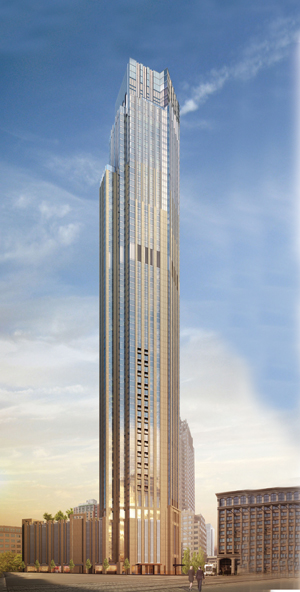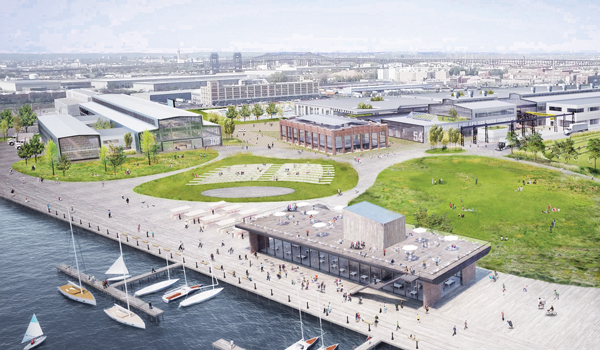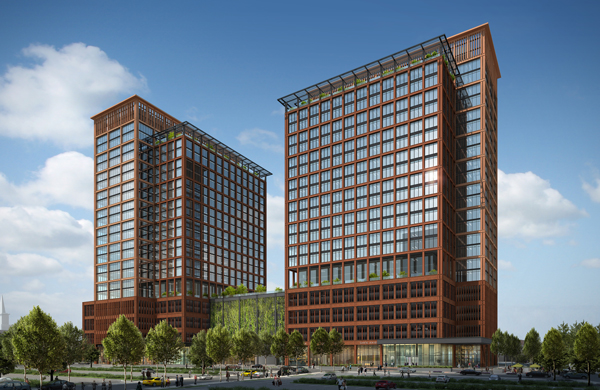Amid all the construction across northern New Jersey, a handful of real estate projects stand out for the sheer size of their ambition. From new, gleaming waterfront towers that rival New York City’s skyline to massive redevelopments of former factory sites, developers are placing large bets that people and companies will buy into a new New Jersey.
Some projects have taken long and winding roads toward completion. The American Dream Mall in East Rutherford, which was originally proposed in 2003, is now scheduled to open in the fall. The $2.5 billion Riverton development in Sayreville, which was originally conceived as an enclosed mall more than 20 years ago, should begin construction by 2020.
New Jersey also has large areas of land open to development that have not been available for many years. “In Northern Jersey, [development is] happening in areas that have changed what they are,” said Brian Whitmer, an executive director within Cushman & Wakefield of New Jersey, Inc.’s (C&W) Capital Markets Group.
In shore towns like Asbury Park and Long Branch, plots have been assembled so that bohemian summer destinations can be reinvented as modern residential communities. Where heavy industry has given up its nearly century-long presence in cities like Harrison and Newark, developers and designers are revitalizing the urban core with mixed-use projects.
Below, The Real Deal identifies six major developments that are transforming the terrain of the Garden State, from the Jersey Shore to the Meadowlands.
1. Renewing Urban Centers
Broad Street Axis
Developer: SJP Properties & Aetna Realty
Estimated cost: $1 billion
SJP Properties is continuing its efforts to revitalize Newark with a planned repurposing of the 3.7-acre site that once housed a Westinghouse Company factory in Newark. The Broad Street Axis project, a joint venture between SJP and Aetna Realty, has an estimated $1 billion budget and the potential for 2 million square feet of mixed-use space. The property has been vacant since the mid-1980s, when Westinghouse moved to Florida, but SJP Executive Vice President Peter Bronsnick said the composition of the redevelopment and the timeline for completion are dependent on the eventual tenants.
Bronsnick said the “lack of clarity” from the state on a new incentive program for developers and businesses was a major obstacle in securing tenants.
New Jersey is developing a new “tool kit” to encourage development, said Tim Sullivan, CEO of the state’s Economic Development Agency (NJEDA). Grow NJ, the jobs program created to draw workers from established companies to offices in New Jersey, will be become NJ Forward, with a focus on attracting corporate headquarters, high-growth industries and businesses in Opportunity Zones. The Economic and Redevelopment Growth (ERG) program is slated to become NJ Aspire, a gap-funding finance tool designed to “support the innovation economy and target urban centers and transit-rich downtowns,” according to Gov. Phil Murphy’s office.
“In our conversations with the financial and technology companies of the world, everybody is anxiously awaiting the new incentive program for New Jersey,” Sullivan said. “I’m concerned there will be a gap when there will be no incentives, which is problematic.”
The plan for Broad Street Axis will continue SJP’s goal of helping to revitalize Newark. Parsippany-based SJP has already built a 20-story headquarters for Prudential Financial at the other end of Broad Street, and Bronsnick believes a technology corridor can also be built out.

99 Hudson in Jersey City
2. Environmental Recovery
Riverton
Developer: North American Properties
Estimated cost: $2.5 billion
The National Lead Industries paint factory near the Raritan River in Sayreville had an impact for decades after it closed. The surrounding land and water were left polluted, but now, after nearly 20 years of extensive environmental remediation, North American Properties is almost ready to begin construction on a $2.5-billion mixed-use development plan at the 400-acre site.
Plans for Riverton, as the project is to be called, include more than 1,000 residential units, 750,000 square feet of retail and office space and three hotels. North American Properties aims to build a “Main Street format” community — a far cry from the shopping mall that was originally planned for the site.
Environmental remediation is finally nearing completion, and vertical construction is scheduled to begin in the spring of 2020. One major hurdle to overcome, however, is working with state and local agencies on “tax incentive public finance programs that are crucial to the viability of the project,” said North American Properties project executive Kevin Polston, who added that the developer was submitting new applications for ERG grants.
3. Going Vertical
99 Hudson
Developer: China Overseas America
Estimated cost: Nearly $1 billion
Towers have been going up along the
western shore of the Hudson River for years, but the development trend will reach its peak soon with the completion of 99 Hudson in Jersey City. The 900-foot, 79-story tower is the tallest ever built in New Jersey. Designed by Perkins Eastman and developed by China Overseas America, which paid $70 million in cash for the site in 2013, the 1.4 million-square-foot structure is the tallest U.S. residential building outside of Manhattan and Chicago.
The tower, containing 781 condominium units, includes luxury amenities such as a 24-hour concierge, fitness center and spa. An eighth-floor deck will also boast a 3,000-square-foot swimming pool, private cabanas and dog run.
“There’s not going to be too many on the horizon the size of this one,” said Anthony Cosenza, a senior vice president at Plaza Construction, which is building the tower. He said that the building will be ready for occupancy later this year or early 2020.
4. Building Up The Shore
Asbury Park Waterfront
Developer: iStar
Estimated cost: $1 billion
When Bruce Springsteen released “Greetings from Asbury Park” in 1973, the Shore town was a bohemian outpost, but iStar’s roughly $1 billion, 20-year redevelopment plan for 35 acres of waterfront land is remaking it for the 21st century.
“When we first started our redevelopment of the Asbury Park waterfront, what stood out was the amount of vacant land and abandoned buildings,” said Brian Cheripka, iStar’s senior vice president of land and development. The plan calls for 20 projects to be built, including townhomes, luxury condominiums, hotels and entertainment venues.
Eight years into the work, iStar has already transformed a Salvation Army building into a hotel and opened the Monroe, a 34-unit luxury condominium building. It also relaunched the Asbury Lanes bowling alley, bar and music venue with none other than Springsteen playing the first show.
The next big step will come this summer with the opening of the Asbury Ocean Club, a 17-story boutique hotel and condo tower overlooking the boardwalk.
Cheripka believes the full build could occur in the next eight to 10 years, depending on market conditions. “We are comfortable that we can begin to accelerate the pace of development, and that we can look to create a more robust pipeline of projects to include joint ventures and land sales to third-party developers,” he said.

Kearny Point
5. Incubating Future Industries
Kearny Point
Developer: Hugo Neu Realty Management
Estimated cost: $1 billion
The 130 acres that are becoming Kearny Point, a commercial campus and incubator, have seen the entire cycle of redevelopment. Originally a place that built ships for the U.S. Navy, the site became a shipbreaking and recycling facility for years before the whole area was washed out by Superstorm Sandy in 2012. Hugo Neu Realty Management is now in the midst of a $1 billion project to build high-tech offices, creative manufacturing spaces and an incubator for environmental technology startups.
“Without exception, everyone else we talked to thought we were crazy,” said Hugo Neu CFO Steve Nislick. “Even though the location was a little odd because there was no office space in Kearny, New Jersey, I just felt it would be successful.”
With the first office building opening in 2015 and a second building being renovated last year, Hugo Neu will begin retrofitting another 10,000-square-foot building in 2020.
A commitment to environmental technology runs through the project. The developer is raising the entire site to 4 feet above the FEMA flood plain level to protect against rising sea levels and is working with the state’s Department of Environmental Protection to test a new technology to sequester polluted soil from the site’s industrial past.
“Our plans are to have partnerships with local universities and large companies that have an interest in these environmental technologies,” Nislick said.
6. Let’s All Go To The Mall
American Dream
Developer: Triple Five Group
Estimated cost: $5 billion
Even though its opening has been pushed back, again, to later this year, the $5 billion American Dream development in East Rutherford will finally become a reality after 16 years of frustration.
Edmonton-based Triple Five Group took over the 3 million-square-foot megamall project in 2011, after two previous owners had already invested $1.9 billion in construction.
The retail landscape has changed dramatically since 2003, when the massive Meadowlands site was launched as Xanadu. Triple Five, which also owns the Mall of America in Minnesota, has transitioned away from traditional mall design to meet consumer demand.
Lord & Taylor and Saks Fifth Avenue are signed on to anchor the retail space. When it finally opens, however, the majority of American Dream’s interior will be devoted to entertainment. There will be an indoor ski slope and water park, an aquarium and a Cirque du Soleil show. To add to the circus atmosphere, helicopters will reportedly be available to deliver shoppers to North Jersey from Manhattan.
“The proof is in the pudding on how their leasing has gone,” Cushman’s Whitmer said. “What they are building is what everybody wants.”
